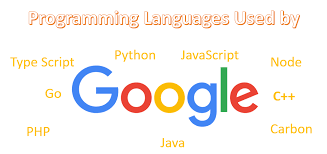As we approach 2024, the landscape of programming languages continues to change, driven by technical developments, industry demands, and community preferences. Google, a worldwide technology and innovation leader, contributes significantly to the programming language ecosystem through its projects, frameworks, and developer tools. Here are some of the most used programming languages in Google’s ecosystem as of 2024.
7 Google’s Top Programming Languages
1. Python
Python remains a programming powerhouse, favored for its ease of use, adaptability, and readable code. Python is a popular choice at Google for a variety of applications, including web development, data analysis, machine learning, and automation. Google’s support for Python is obvious in the creation of frameworks such as TensorFlow and libraries such as Pandas, both of which are widely used in AI and data science applications.
2. JavaScript
JavaScript continues to dominate web development due to its importance in generating dynamic and interactive web applications. Google’s concentration on web technologies, as evidenced by initiatives such as AngularJS (Angular) and the development of the Chrome browser, highlights the importance of JavaScript within the corporation. Google’s dedication to improving JavaScript frameworks and tools guarantees that it remains relevant in modern web development methods.
3. Java
Java remains a cornerstone of Google’s enterprise-level programming, notably for creating scalable and dependable backend systems. Android, the world’s most popular mobile operating system, relies heavily on Java for app development. Google’s continued support for Java frameworks and libraries, as well as its use in cloud-based solutions such as Google Cloud Platform (GCP), highlight its importance in the company’s technology stack.
4. Go (Golang)
Go, often known as Golang, has progressively gained favor at Google thanks to its efficiency, concurrency support, and simplicity. Go, developed internally by Google engineers, is well-suited for constructing scalable and performant systems, making it a popular choice for cloud infrastructure and distributed systems on Google Cloud. The language’s resilience, as well as Google’s support for its use in backend services, demonstrate its growing importance in the company’s ecosystem.
5. Kotlin
Kotlin, launched as a modern alternative to Java for Android app development, continues to gain traction inside Google. Kotlin is popular among Android developers due to its concise syntax, Java interoperability, and better safety features. Google’s explicit endorsement of Kotlin as the preferred language for Android app development strengthens its position, providing developers with a more productive and efficient programming environment.
6. Dart
Dart, developed by Google, is the programming language for Flutter, Google’s UI toolkit for creating natively built mobile, web, and desktop apps from a single codebase. Dart’s robust type system, performance enhancements, and JavaScript compatibility make it an essential component of Google’s goal to simplify cross-platform app development. Dart’s relevance within Google’s ecosystem is growing as Flutter becomes more popular among developers.
7. Rust
Rust, recognized for its emphasis on safety, efficiency, and concurrency, has emerged as the favored language for systems programming at Google. Google recognized Rust’s promise of producing secure and efficient software by adding it to projects such as Fuchsia OS and Google Chrome components. The language’s strong compiler tests and memory safety measures are consistent with Google’s goal of developing dependable and scalable systems.
Conclusion
Google’s impact on the programming language landscape is significant, thanks to its strategic investments, open-source contributions, and developer community engagement. The predominance of languages such as Python, JavaScript, Java, Go, Kotlin, Dart, and Rust in Google’s ecosystem shows their diversity, performance capabilities, and unity with the company’s technical goals.
As we approach 2024, these top programming languages will continue to play important roles in Google’s software development techniques, ranging from AI and machine learning to web and mobile app development. Understanding their capabilities and uses sheds light on current trends and future orientations within Google and the broader tech industry.
